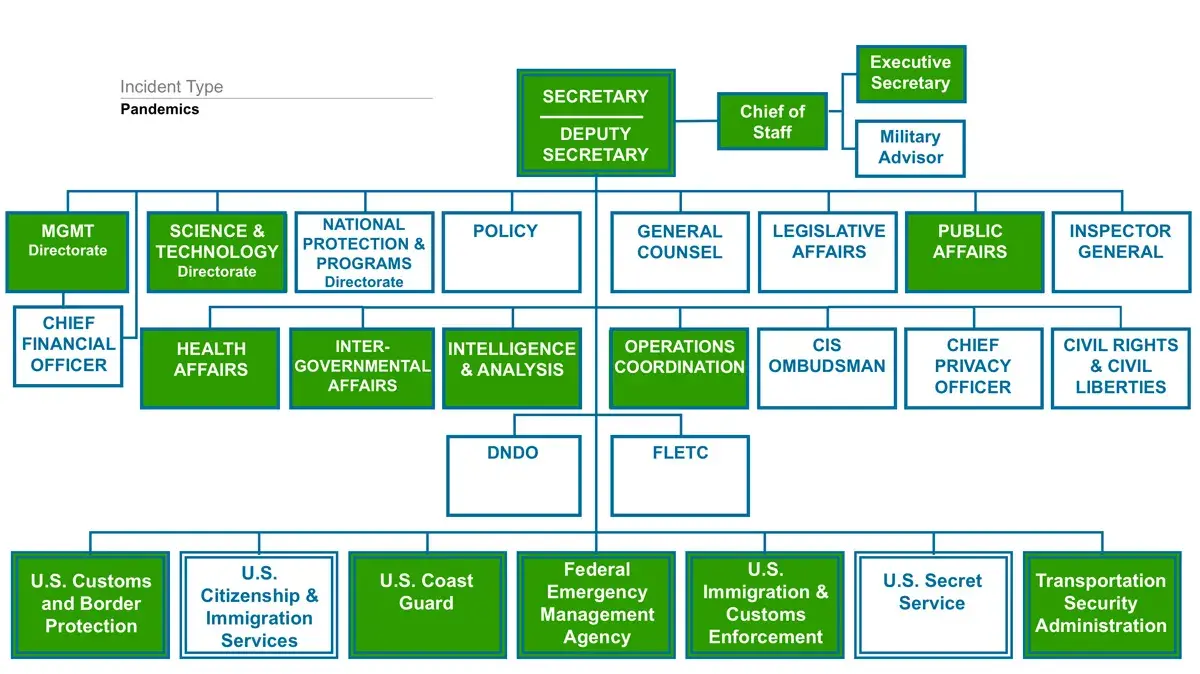A pandemic is a global epidemic of an infectious disease. Here’s what DHS does to mitigate the impact of a pandemic on homeland security, health and safety, critical infrastructure and the basic functions of American society.

Download "Incident Type: Pandemics" (255KB JPG)
Secretary
- The Secretary of Homeland Security is the principal Federal official for domestic incident management.
- Coordinates the Federal response, assuring the full function of the nation’s critical infrastructure and key resource sectors.
- Shares reports from the Office of Health Affairs on the spread of the virus and Federal response activities with the White House and other Cabinet-level officials.
- Activates Regional Coordination Teams to support emergency management operations with inter-agency, state, and local partners in the affected regions
Office of Intergovernmental Affairs
- Leverages its existing relationships with inter-agency, state and local government entities to disseminate information in real-time and ensure a coordinated focus across all levels of government
- May hold daily meetings and teleconferences between DHS and state and local partners, such and Governors and Mayors, to identify and flag areas of concern for the Secretary
Office of Public Affairs
- If the Emergency Support Function (ESF) for External Affairs is activated, the National Joint Information Center (NJIC) will coordinate with and supports the White House, Secretary of Homeland Security, the National Operations Center (NOC), and the National Response Coordination Center to coordinate the Federal communications response.
- Coordinates messaging with the U.S. Department of Health and Human Services. May also coordinate with international partners such as the World Health Organization and foreign governments where necessary if the pandemic stretches beyond U.S. borders
- Keeps abreast of public concerns to allow DHS and other government leaders to address those concerns
Office of Health Affairs
- Acts as the principal medical authority for the Department of Homeland Security
- Through its National Biosurveillance Integration Center, coordinates all medical and public health and surveillance efforts, and provides senior DHS leaders with a comprehensive picture of ongoing incidents and outbreaks, both domestically and overseas
- Prepares timely reports for the Secretary of Homeland Security and other DHS leaders
- Provides health and medical guidance to DHS’ operational components to protect DHS personnel who may come into contact with potentially infected people and surfaces, and ensure that they are able to continue to execute their mission-critical functions during a pandemic
Office of Intelligence & Analysis
- Gathers information to maintain awareness of events that may be of interest from an intelligence perspective
- Shares this information with the Office of Health Affairs and the Office of Operations Coordination who maintain situational awareness of Federal response activities
Office of Operations Coordination
- Assesses the threat situation posed by the virus in terms of risk, impacts and required response; may use this analysis to designate the outbreak a “threat of interest”
- Gains and maintains situational awareness through its National Operations Center, which serves as the national fusion center, collecting and synthesizing information related to the waves of outbreak
- Develops a Common Operating Picture (COP) the foundation for timely and accurate decision making during fluid conditions
Directorate for Management
- Provides guidance to DHS personnel, who through their line of duty—such as interacting with travelers and screening cargo—are at greatest risk of exposure, on the use of personal protective equipment and other risk mitigation behavior in order to ensure they remain safe and are able to continue effectively serving the public
Science and Technology Directorate
- Develops surveillance, prevention and operation capabilities for detecting and countering biological threats
- Deploys BioAssays that rapidly screen and detect pathogens and toxins, allowing first responders and public health officials to rapidly analyze samples and take appropriate defensive actions for public safety and public health
- Deploys technologies that support the clean-up and decontamination of surfaces and physical structures where a biological incident has taken place (i.e. tunnels, train stations, subway cars)
United States Customs and Border Protection (CBP)
- Funnels international flights bound for the United States, that originated from countries where the outbreak is prevalent, into select airports for enhanced screening procedures
- Screens for potentially sick travelers through visual assessments looking for overt signs and symptoms (e.g. temperature checks in the case of Ebola virus)
- Isolates and refers ill travelers to CDC Quarantine Station staff and public health officials
- Refers/transfers custody of animals or agricultural products that may be infected to CDC Quarantine Station staff
Federal Emergency Management Agency (FEMA)
- Activates its network of Regional Response Coordination Centers to coordinate Federal emergency management operations
- Supports the U.S. Department of Health and Human Services in immunization and vaccination efforts, particularly through providing logistical support for vaccine distribution and administration
United States Immigration and Customs Enforcement (ICE)
- Implements measures to prevent and contain spread of the outbreak among employees and/or individuals in ICE custody
Transportation Security Administration (TSA)
- Provides awareness of the outbreak and guidance to the aviation industry on recognizing outbreak symptoms, and sets up communication channels to address industry concerns
- Vets all airline passengers coming to, departing form or flying within the U.S. to ensure that anyone on the “Do Not Board” list—a list of individuals who may be infected with a highly contagious disease and therefore present a threat to public health—is prevented from traveling via commercial aircraft
- Supports CDC requirements to identify all passengers where it has been determined that one or more passengers present a biological risk
- Ensures that Transportation Security Officers and other employees are trained, aware, and provided with personal protective equipment where necessary
United States Coast Guard (USCG)
- Monitors vessels known to be inbound from outbreak-affected countries
- Relays this information to Captain of the Port, District, and CDC representatives
Health and Human Services
- Acts as the lead Federal agency for addressing public health threats
Centers for Disease Control and Prevention
- Shares data with the DHS Operational Planning Team
